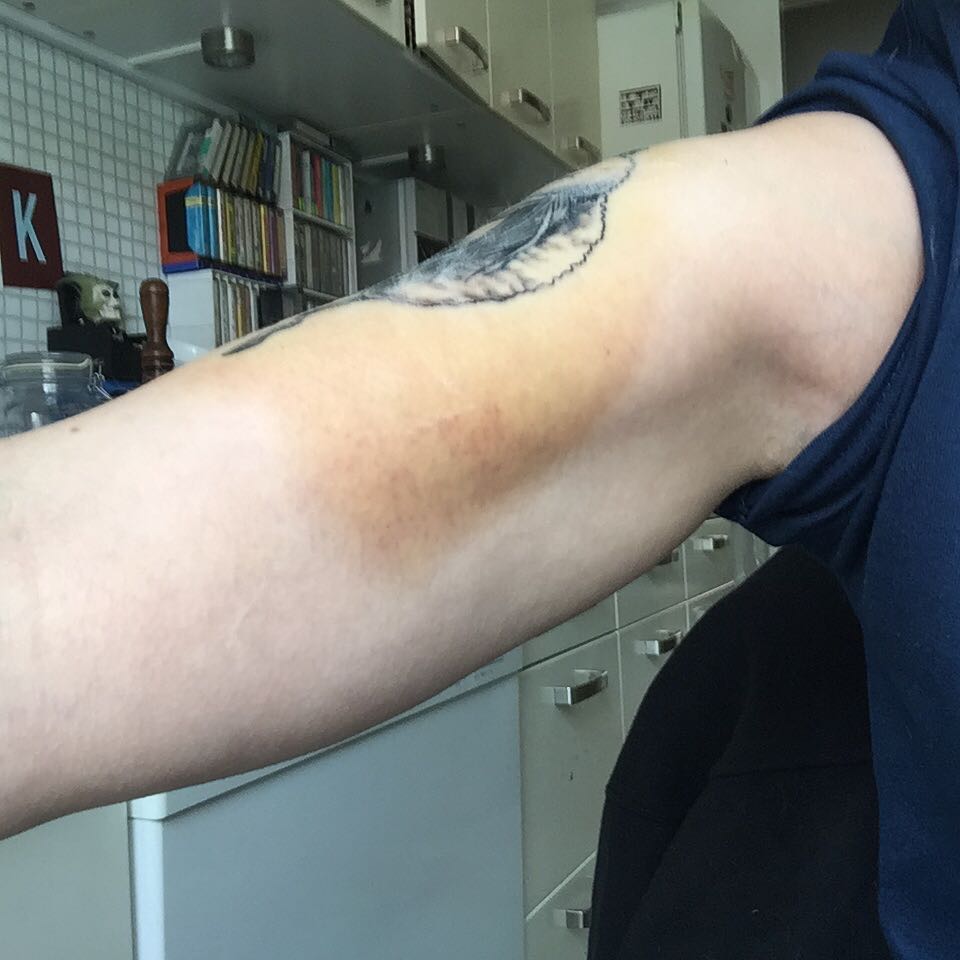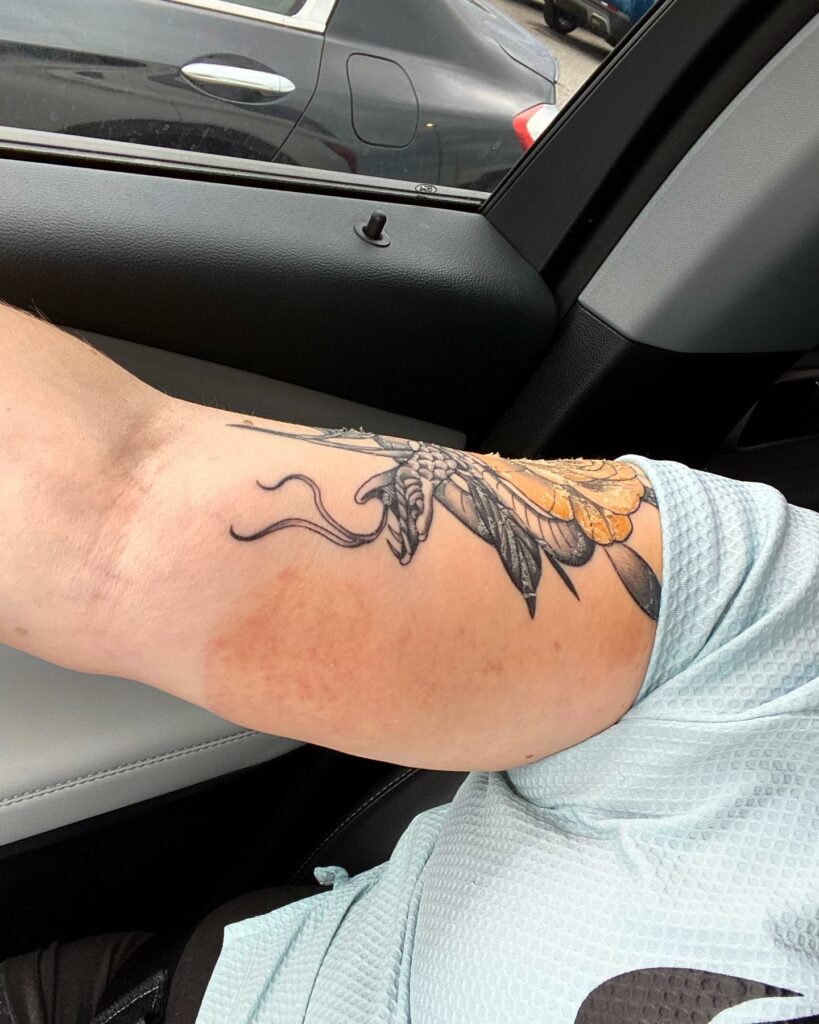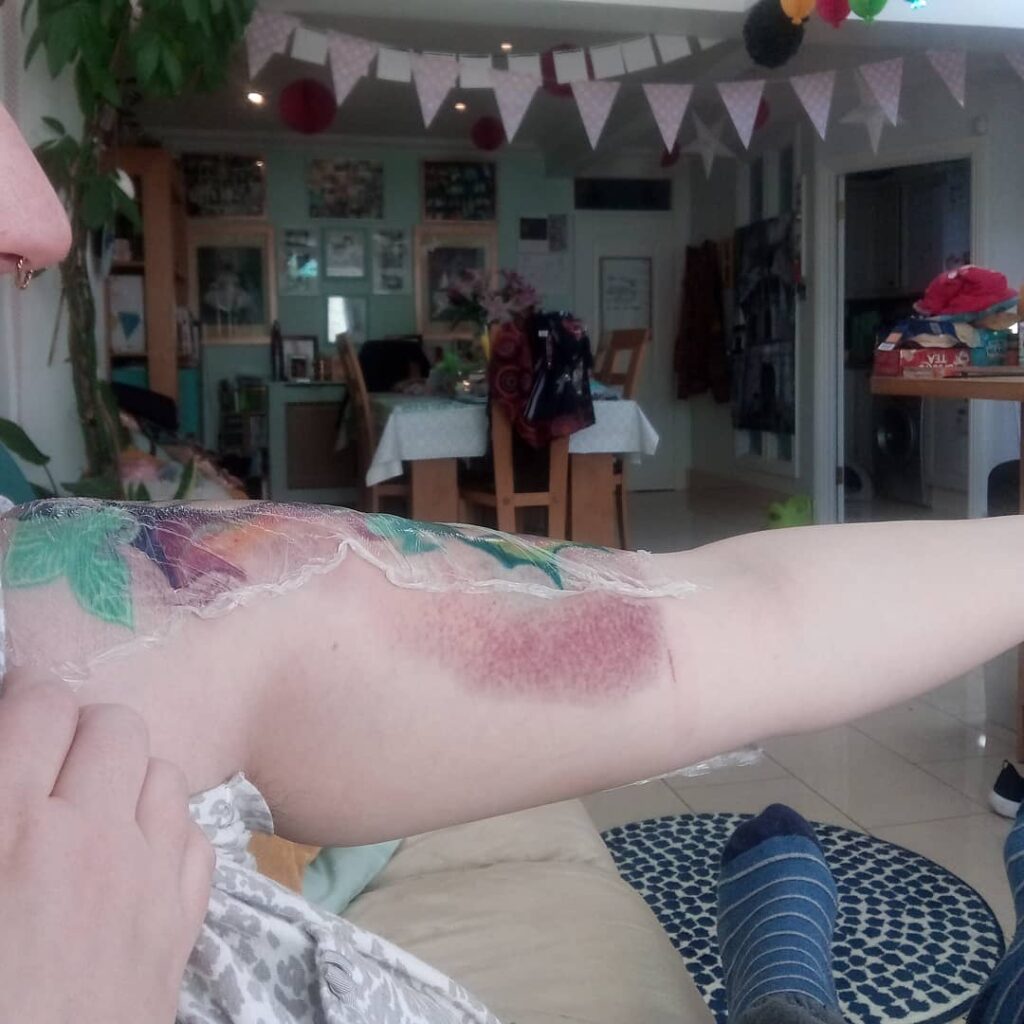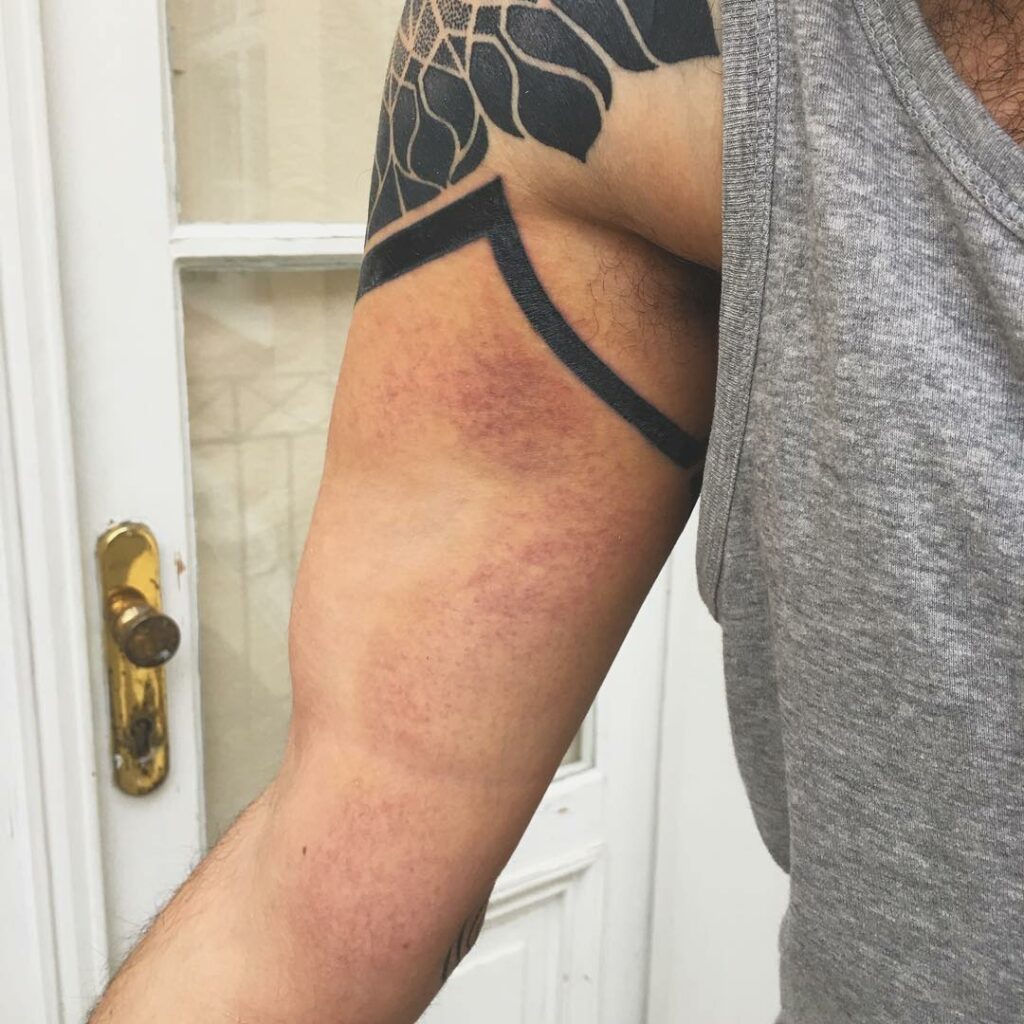Table of Contents
Today we’re diving deep into the purplish-blue unknown, the unsung ballad of tattoo aftercare. Those splendid and intriguing blotches that occasionally pop up after a session in the artist’s chair – we’re unmasking the mystery behind them and exploring the realm of tattoo bruising.

Before you squirm, let’s be clear: I’m not here to scare you off, but to hand you the knowledge torch to navigate this terrain like a pro. A little bruising is perfectly normal, often just a rite of passage on your journey to sporting spectacular skin art. But what causes it, and more importantly, how do we handle it? That’s the meat and potatoes of our chat today.
With the smudge of ink on my gloves and years of experience etched into my memory, I’m here to give you a comprehensive breakdown on Tattoo Bruising: Causes & Treatment. Buckle in – okay, I know I said no “buckle up”, but c’mon, I didn’t say anything about buckling in, right? We’re about to delve into some colorful science, dispel a few myths, and share pro tips to transform you from a tattoo enthusiast to a veritable ink connoisseur.
The Inky Mystery: Decoding Tattoo Bruising

If you’re the type who’s been startled by a vivid purple bloom around your fresh tattoo, you’re in the right place. Remember that time I inked a gorgeous phoenix on my lower leg? Yeah, it looked like a grape harvest had exploded around it! But fret not, my friends, this is a part of the process, and usually, it’s nothing to panic about.
Is Tattoo Bruising Normal & Why Do Tattoos Bruise?
Not all tattoos result in bruising, but it’s not exactly a rare phenomenon either. The whole tattoo process can be a bit of a shock to your skin, and sometimes, it responds with a resounding “Ouch!” in the form of a bruise. The trauma caused by the tattoo needles piercing your skin repeatedly bursts tiny veins beneath the surface, which can result in a bit of blood pooling in the surrounding tissue. This is what gives you that funky, technicolor bruise. They can be all shades from bright yellow to brown and even black. A bit alarming, perhaps, but typically harmless.

A Deeper Look: Why Is Your Tattoo Bruising Heavily?
When it comes to heavy bruising, several factors can come into play.
Tattoo Location
If you’ve ever banged your shin on a coffee table, you know how easily the lower extremities bruise. The same holds true for tattoos. Locations like feet and ankles, where gravity pulls the blood downwards, are more likely to bruise. Thin-skinned areas, such as the inner bicep and wrist, can also bruise due to their delicate nature. Remember that chrysanthemum I inked on my inner wrist? Looked like I’d arm-wrestled a gorilla!
Tattoo Artist Technique

The tattoo artist’s technique can impact bruising as well. While some artists are as gentle as a summer breeze, others may have a more forceful approach, which can result in a bruise making its appearance in the following days.
Medication
Medications that thin the blood can cause heavier bleeding during the tattoo process, leading to potential bruising. The usual suspect here is aspirin. It prevents blood clotting efficiently, which can prolong the under-the-skin bleeding. Always consult with your healthcare provider and your tattoo artist before getting inked while on any medication.
Infection
Although rare, bruising could be a symptom of an infection, typically accompanied by redness, a rash, or a fever. In such cases, prompt medical attention is vital.

Some People Just Bruise Easily
Let’s face it, some folks are just more prone to bruising. If you’re one of them, don’t fret if your new tattoo shows some signs of bruising.
It May Not Even Be A Bruise
What you might be considering a bruise could be something entirely different, such as a tattoo ‘blowout’ – a consequence of tattoo needles depositing ink too deep into your skin. Unlike a bruise, a blowout does not fade over time. So, when in doubt, consult with your tattoo artist.
How long does it typically take for a tattoo bruise to fade?
The duration of a tattoo bruise can vary depending on several factors such as the location of the tattoo, your personal health, and how well you care for the bruised area. Generally, a bruise from a tattoo might start showing up a few hours to a couple of days after the tattoo process and will typically take around 1-2 weeks to completely fade. However, it’s important to note that each person’s body heals at a different rate, so this is just a rough estimate.
Remember, if your bruise doesn’t start to fade after two weeks or if you notice other alarming symptoms such as excessive swelling, redness, or fever, you should consult with a healthcare professional to rule out any potential complications. Always listen to your body and take care of your new ink!
How To Treat Tattoo Bruising

While a bruise will eventually fade on its own, here are a few tricks to help expedite the process:
Ice Compression
Applying a gentle ice compress can restrict blood flow to the bruised area. Remember to cushion the ice with a damp towel to avoid direct contact with your sensitive, freshly tattooed skin.
Elevation
If your tattoo is on the lower half of your body, try elevating it above your heart level when lying down. This encourages the blood to disperse away from the wound.
Rest

Take it easy post-tattoo to give your body the best shot at healing. Intense exercise immediately after a tattooing session can potentially increase bruising due to a temporary spike in blood pressure.
As we navigate the vibrant world of tattoos together, remember that a little bruising is part of the journey. After all, it’s not just about the destination (a fabulous tattoo), but also about understanding and embracing the process. Stay tuned for more enlightening ink talk with Tori!
Common Myths About Tattoo Bruising?
There are quite a few myths about tattoo bruising that can cause unnecessary worry. Let’s dispel some of the most common ones:
- Myth: “Tattoo bruising means the artist did a poor job.” Fact: Bruising can occur with both seasoned and novice artists. It’s often simply a result of how your body responds to the tattooing process. The artist’s technique can play a role, but a bruise doesn’t automatically mean the tattoo was poorly done.
- Myth: “A bruised tattoo will be permanently discolored.” Fact: While a fresh bruise can make your tattoo look discolored, this is temporary. As the bruise heals, your tattoo’s true colors should shine through.
- Myth: “Bruising only happens with certain colors of ink.” Fact: The color of the ink has no impact on whether or not a tattoo bruises. It’s the physical process of tattooing, not the ink itself, that can cause bruising.
- Myth: “If my tattoo didn’t bruise, it won’t heal properly.” Fact: Lack of bruising has no correlation with poor healing. In fact, some people just don’t bruise easily and their tattoos still heal perfectly fine.
- Myth: “If I apply more aftercare products, the bruise will heal faster.” Fact: Overusing aftercare products won’t speed up bruise healing and can actually harm the tattoo. It’s important to follow the aftercare instructions provided by your artist.
Remember, while the internet can be a source of useful information, it’s always best to consult with a professional if you have any concerns about your tattoo.
Are There Any Long-term Effects Of Tattoo Bruising?
In most cases, there are no long-term effects from tattoo bruising. As mentioned earlier, tattoo bruising is usually a normal part of the body’s response to the trauma caused by the tattoo needle. After a couple of weeks, the bruise should fade away completely without leaving any permanent marks or damage to the tattoo itself.
However, there are some instances where bruising could potentially indicate a more serious issue. For example, if the bruise doesn’t start to fade after two weeks or so, or if it’s accompanied by other symptoms like extreme swelling, redness, or a fever, this could be a sign of a tattoo infection or an allergic reaction to the tattoo ink. If left untreated, these conditions could potentially have long-term effects, both on your health and the appearance of the tattoo.
In other rare cases, what appears to be a bruise could actually be a tattoo blowout. This happens when the tattoo needle inserts the ink too deep into the skin, causing it to spread out into the surrounding tissue layers. This can give the appearance of a bruise, but unlike a bruise, a tattoo blowout won’t fade over time. Instead, it can lead to a blurred or smudged appearance in the tattoo.
In any case, if you have any concerns about bruising or other symptoms following a tattoo, it’s always a good idea to consult with a healthcare professional or a knowledgeable tattoo artist. They can help determine whether what you’re experiencing is normal or if there’s something more serious that needs to be addressed. As always, it’s better to err on the side of caution when it comes to your health and well-being.
Conclusion
Alright, folks, it’s time to wrap up our fascinating voyage into the world of tattoo bruising. Remember, bruising is a common response to the tiny trauma inflicted by the tattooing needles. While it can look a little gnarly, it’s usually nothing to lose sleep over. Keep in mind the factors that can contribute to heavier bruising: tattoo location, the artist’s technique, certain medications, or just your unique bodily response. If you notice any signs of infection like excessive redness, swelling, or a fever, don’t hesitate to seek medical attention.
When it comes to treating a tattoo bruise, remember the three key steps: apply a gentle ice compress, elevate the tattooed area if possible, and take it easy for a few days post-inking. Patience is your best friend here – your body is doing its thing, and before you know it, that bruise will fade away, leaving behind your stunning piece of body art.
But most importantly, enjoy your tattoo journey! It’s a unique form of self-expression and a testament to the amazing resilience of our bodies. Be informed, be proactive, and continue to nurture your love for ink. After all, every tattoo has a story to tell – and yes, that includes the occasional bruise! Keep exploring, keep learning, and wear your tattoos, bruises and all, with pride. This is Tori, signing off until our next ink-filled adventure. Happy tattooing!




